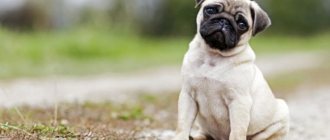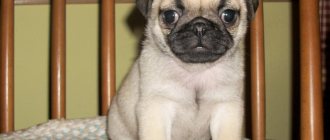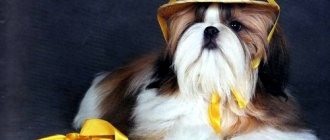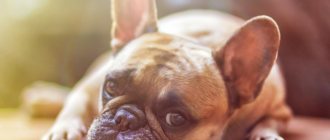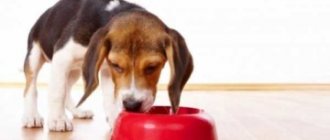Host Responsibilities
Procedures that a pug owner should carry out daily:
- examine the eyes;
- control the purity of the water in the bowl;
- walk the animal twice a day;
- Brush his fur regularly.
Expert opinion
Anna Abramenko
An avid dog lover. Experience in veterinary medicine since 2009.
Ask a Question
Also, the owner should wipe the folds of the animal’s muzzle, brush its teeth and ears every day. Bathe him monthly and trim his nails. Once a season, carry out antiparasitic therapy and take him for examination to a veterinarian.
Puppy care
How to care for a bear-type Spitz: keeping in an apartment
The basic rules for caring for a tiny pug puppy are similar to the canons of caring for other dogs such as brachycephalics and require owners to show increased attention. Animals of this type have shortened respiratory tracts, so they are not very active physically and do not tolerate heat.
Important! Quite frequent wheezing and shortness of breath is a reason to take your pug to the vet.
Puppies of this breed are curious, like all babies, so special attention should be paid to the safety of the animal: cover sharp corners, remove small and sharp objects, as well as wires from reach, and do not leave the fidget alone in the room.
Pug puppies are very curious
Important! To pick up a puppy, place one hand under the chest and the other under the tail. Under no circumstances should you lift an animal by the scruff of the neck.
Genetically, pugs are predisposed to a lazy lifestyle fraught with depression and melancholy. Therefore, an important point in the rules on how to care for a pug is a sufficient amount of physical activity - walks (twice a day), play training, as well as proper feeding. Otherwise, dogs are at risk of obesity and problems with the cardiovascular system.
Dietary rules and prohibited foods
The diet should be appropriate for the age of the dog. For the first 3 months of their life, pug puppies are in a stage of accelerated growth. It is at this time that the foundation for the health of a mature dog is laid. Meals during this period should be frequent and plentiful.
This is interesting: 10 foods that should not be given to a pug
A newborn puppy is fed by its mother. If this is not possible, then for his survival, you should purchase a veterinary formula and feed him according to the doctor's recommendations. To do this you will need a special nipple and a small bottle. An alternative could be regular baby formula. Conventional cow or goat milk has too low a fat content.
Small puppies from 2 months should be fed 4 times a day. Food should be rich in calcium. For breakfast, the pug should be given kefir and low-fat cottage cheese.
The dog has stewed vegetables for lunch. Porridge can also be a source of carbohydrates. Grind buckwheat, pearl barley, rolled oats or rice in a coffee grinder, boil and add salt. You can add boiled yolk to vegetables or porridge. Older puppies should be given a small piece of rye bread with butter or one dried fruit as a supplement.
For dinner, small pugs should be fed finely chopped meat (lamb or beef). There should be no fat in it, so minced meat is not suitable for feeding puppies. If the baby is already 2 months old, you can boil porridge for him in meat broth.
This is interesting: Where to buy a pug puppy
After three months, puppies should increase their food intake. From this point on, you can introduce more meat and cereals into your diet, and gradually add raw vegetables and fruits. When feeding, it is important to adhere to the principle: give light foods in the first half of the day, and lean meat in the second. Gradually, the number of feedings can be reduced to three, provided that the dog is not hungry.
Expert opinion
Anna Abramenko
An avid dog lover. Experience in veterinary medicine since 2009.
Ask a Question
During the period from 7 to 12 months, the puppy should be gradually prepared for the transition to adult food. Food is served 2 times. In the morning: cereals, vegetables, fruits, dairy products. In the evening: meat, bones and fish.
Your dog should always have clean, fresh water in his bowl.
After the puppy turns one year old, you can continue the same diet based on homemade food or switch to dog food.
Advantages of each power system:
| Natural food | Ready-made feed |
| Homemade food is healthier and more nutritious. It contains no preservatives or flavorings | There is no need to think through a balanced diet. The amount of nutrients and trace elements per serving complies with veterinary standards. Special formulations have been developed for dogs with allergies, which eliminate the need to purchase additional vitamins. Such food is convenient to take on the road. |
Expert opinion
Anna Abramenko
An avid dog lover. Experience in veterinary medicine since 2009.
Ask a Question
Dryers for animals are divided into three classes: economy, premium and superpremium. The first category is characterized by the use of low quality raw materials. This includes the cheapest food from supermarkets.
Premium is a product in the mid-price category. This food can be found in supermarkets and veterinary stores.
Super premium is sold exclusively in pet stores. They are developed in scientific laboratories taking into account the breed, its lifestyle, and the presence or absence of diseases.
Adult pugs are unpretentious in terms of nutrition and can eat almost any food that a person eats. However, feeding them table scraps is prohibited. This breed has a sensitive gastrointestinal tract, and such food can cause illness or death for it.
Expert opinion
Anna Abramenko
An avid dog lover. Experience in veterinary medicine since 2009.
Ask a Question
A weak gastrointestinal tract often manifests itself as heartburn. In order to soften it, it is necessary to give the dog milk of medium fat content - up to 2.5%.
Pugs love sweets, but eating them is dangerous to their health. High sugar levels can lead to the death of the animal. Baked goods, sausages, fatty and fried foods are prohibited.
Hygiene
You should wash your pug once a month. For water treatments you need dog shampoo. More frequent washing can damage the animal's hair, as natural lubrication protects it from dry skin and irritation. After walks, just wipe the paws, and if the fur gets dirty, rinse it with water without shampoo.
Expert opinion
Anna Abramenko
An avid dog lover. Experience in veterinary medicine since 2009.
Ask a Question
You should not bathe your pug often in an attempt to get rid of the specific animal odor. Frequent washing stimulates the dog's sebaceous glands and the smell can only intensify.
Walks
Cold, heat, and sudden temperature changes have a bad effect on the animal’s well-being. Therefore, this breed tolerates being kept in any apartment well and does not require long walks.
This is interesting: 10 dogs that will not cause inconvenience in the apartment
A pug can be walked from three months of age. By this point, the puppy has already received all the necessary vaccinations and easily adapts to the environment. Young dogs are active and inquisitive, and too much stress can harm their cardiovascular system. Therefore, before your pet turns 1 year old, you should take him on short (up to 15 minutes) gentle walks 3-4 times a day.
Adult pugs are not litter trained well and require walking 2-3 times a day. Optimal duration: 30-40 minutes. Sometimes active games on the court are acceptable.
Expert opinion
Anna Abramenko
An avid dog lover. Experience in veterinary medicine since 2009.
Ask a Question
Rare and short-term exercise can lead to obesity and muscle atrophy in the dog. Long and tiring ones harm her heart and respiratory system.
In cold, windy, rainy weather, it is recommended to wear an insulated waterproof suit on your pet. For walks, a harness is preferable to a collar - it minimizes the load on the spine.
Dog nutritional features
A complete and balanced diet is the basis for a healthy diet for a pet. The daily diet, as well as the amount of food given, varies depending on the age characteristics of the pet and its level of development.
Puppy diet
From the age of one month, it is recommended to transfer the pug puppy to four meals a day, which should be nutritious and rich in calcium. At the age of up to three months, the puppy’s diet is supplemented with low-fat kefir or yogurt with a small amount of linden honey. The menu should also be diversified with fruits, buckwheat and rice porridge, quail or chicken egg yolk and high-quality chopped meat.
At the stage of active growth and development of a pet, the first two feedings involve the use of kefir, yogurt or cottage cheese with honey, as well as stewed vegetables and raw fruits. For the third and fourth feedings, lean poultry, lean beef or rabbit are given, which are chopped and added to porridge. Starting from the seventh month, you need to gradually transfer the puppy to three meals a day .
This is interesting! If necessary, a smooth transition of a pet from natural products to dry or wet “premium” and “super-premium” class diets is carried out.
Adult dog diet
Pugs are a breed of dog prone to allergies and obesity, and also have a not very stable digestive system, so it is very important to properly create a diet or correctly select ready-made, dry and wet food. Ready-made food for a pug should not be lower than the “premium” or “super-premium” class. Experts recommend giving preference to the following complete ready-made diets:
- Brit is a hypoallergenic food based on lamb meat and rice;
- Organix is a ready-made diet intended for feeding sensitive dogs;
- Asana – food intended for feeding pregnant and lactating dogs;
- Bosh is a food used to feed an elderly pug;
- Orijen is a high-protein food, very well suited for feeding pugs with increased activity and puppy dogs;
- Wolfsblut - food that does not cause any allergic reactions in your pet;
- Go Natural Nolistic is a grain-free food that is optimally suitable for dogs of any age;
- Eukanuba Adult is a high-quality protein food that is a source of proteins and is characterized by a reduced amount of fiber;
- First Mate – grain-free food containing fish and potatoes;
- Arden Grange is a very high-quality diet with a high meat component.
Regardless of age, a pug should absolutely not be fed any sugar-containing products, pork, smoked meats and spices or sausages, fatty or fried and salty foods, flour and confectionery products, as well as table food.
Vitamins and minerals
Vitamin-mineral complexes, as a rule, are used only at certain stages of growth and development of a pet, as well as as prescribed by a veterinarian.
Experts recommend giving preference to the following high-quality drugs:
- vitamin complex that improves the condition of coat and skin – Excel Brewers Yeast 8in1;
- vitamin complex that improves the condition of cartilage and bone tissue - “Gelakan Baby”;
- vitamin complex that improves the condition of the cardiac system - Canina Nerz-Vital;
- vitamin complex that improves the condition of bone tissue and teeth – Canina Calcium Citrat;
- a vitamin complex intended for puppies, as well as young pugs - “Kanvit Junior”;
- multivitamin complex – Bearhar;
- vitamin complex for an elderly and insufficiently active dog – Excel Multi Vitamin Senior 8in1.
Also, if there is a lack of vitamin “A”, you should supplement your pet’s diet with milk, liver, fish oil, carrots, tomatoes and herbs, and you can get rid of hypovitaminosis “B” with brewer’s yeast, cottage cheese and kefir, as well as potatoes. To support your pug's immunity, it is recommended not to neglect a variety of vegetables and fruits.
Return to content
Features of care
In good health, Pugs can live 15 years. But, like many artificially bred breeds, they are prone to disease. Therefore, the owner has a great responsibility, since regular care of the pet at home is the key to its good health.
Expert opinion
Anna Abramenko
An avid dog lover. Experience in veterinary medicine since 2009.
Ask a Question
It is more difficult to care for a pug boy, as their sebaceous glands work more actively. As a result, the fur and folds of the muzzle become dirty faster.
Behind the wool
It is necessary to comb your pug daily, as the breed is characterized by constant shedding. Dogs lose especially a lot of hair in spring and autumn. The brush should have frequent metal teeth. You need to comb the animal in the direction of hair growth. Individual loose areas can be trimmed with scissors.
This is important to know: Problems that a pug owner may encounter
Furminators are used to remove undercoat. This procedure reduces shedding several times. But experienced breeders recommend using this tool with great caution, as it injures the structure of the guard hair. The fur may stop growing or begin to grow in any direction (waves, zigzags).
Behind the ears
Once a week you need to inspect and, if necessary, clean your dog’s ears. In order to remove wax, a dry cotton swab and gentle movements are enough. You can use special lotions purchased at a pet store, but they can cause allergies.
Expert opinion
Anna Abramenko
An avid dog lover. Experience in veterinary medicine since 2009.
Ask a Question
Pugs are prone to otitis media. If discharge is visible in the ears or swelling appears in this area, it is advisable to immediately contact a veterinarian.
Behind the eyes
The eyes are the weak point of pugs. Due to the structure of the muzzle, secretions accumulate in this area, which must be removed every day. Otherwise, an exacerbation of infection occurs (including conjunctivitis). Therefore, it is recommended to check the corners of the dog’s eyes daily for the presence of mucus; if there is any, remove it with a damp cloth.
Purulent discharge on any external organs indicates a pet illness. Greenish is a sign of infection. Transparent - a consequence of allergies.
Processing folds
It is necessary to care for your pug every day, since due to their physiology, such dogs are prone to illness. One of the most important procedures for the health of an animal is cleaning the folds on the face. Sebum, dust, water, and food debris accumulate in this area. If you do not clean them out in time, an infection or fungus may develop in the discharge.
For the procedure you will need sticks, wet wipes (for children, for intimate hygiene or for those with allergies). You can use cotton pads moistened with clean water. It is necessary to lift the folds of the pug, treat the area above the nose, near the eyes. You need to repeat until the next napkin or cotton pad comes clean. Wipe folds only if there is discharge on them.
Expert opinion
Anna Abramenko
An avid dog lover. Experience in veterinary medicine since 2009.
Ask a Question
You cannot treat a dog’s face with chlorhexidine, peroxide or miramistin - this will weaken its own beneficial microflora.
Trimming claws
How often your dog's nails need to be trimmed depends on the dog's lifestyle. Active animals walking along asphalt sidewalks wear them down as they walk. If your pet often touches objects with them or is damaged, the length of the growths should be removed.
This procedure can be carried out at home, but it is better to go to a veterinary clinic, since at the base of the claw there is a vascular network that is prohibited from touching with an instrument. This inexpensive manipulation can be performed in almost every veterinary hospital.
You can trim your claws at home using special nail clippers purchased at a pet store. Below, watch the video tutorial, which will tell you the angle and direction of movement that is safe for blood vessels.
Keeping a pug in an apartment
Since pugs are short-haired dogs, they do not need to be washed frequently. Carry out washing if the dog is very dirty. You need to wash your pet with a special shampoo - in this case, simply wash the face with warm water, trying to prevent water from getting into the dog’s ears and eyes. After bathing, dry your pet with a towel, and he will shake off the remaining water himself.
The pug should live in a place in the apartment (house) where there is no draft, heat, excessive sunlight and noise. Don't put a bed in the kitchen; let the pug live in the bedroom or living room. The place needs to be constantly vacuumed, and wet cleaning should be done at least once a week, as pugs shed a lot.
Dog training begins from the moment the pet appears in the house. Let your walks be active - take your puppy’s favorite toys with you.
Important! No matter how pleadingly the cute sniffling dog looks at you, do not feed these representatives of the canine world food from the table - this is strictly prohibited!
Vaccinations
An unvaccinated dog is susceptible to many diseases. Also, without vaccination marks, it cannot be taken on trips. The first vaccination is given to a pug at the age of two months. Before this, you need to ensure that your pet is quarantined - not to allow contact with other animals.
This will be interesting: What name should you not call a pug?
Expert opinion
Anna Abramenko
An avid dog lover. Experience in veterinary medicine since 2009.
Ask a Question
2 weeks before vaccination, the puppy must be given anti-worm medications.
The first vaccination is carried out against plague, enteritis, hepatitis, parainfluenza and a number of other diseases. A second injection is given after 2 weeks. The second course is done at the age of six months, if by this time the puppy’s teeth have completely changed. During this period, the puppy is injected with rabies vaccines and repeated vaccinations against distemper and hepatitis.
Antihelminthic prophylaxis is required every 4 months. After the first vaccination, the veterinary hospital issues a veterinary passport for the animal with notes on the injections given. There they also give you a reminder calendar with a schedule.
Girls of this breed are less hardy and more susceptible to disease.
Menu by month
The pug loves to eat, so it is necessary to constantly regulate the dog’s menu. There is no need to overfeed and pamper with treats to prevent obesity. What to feed your pug:
- Even at an early age, puppies are limited in food. They are fed small doses four to five times throughout the day. At the age of six months, the number is reduced to 3 times, and after 8 months - 2 times a day;
- The menu must include meat. The product is low-fat, so pork is excluded. It is difficult to digest by the digestive tract. Beef and veal are used as lean meat;
- The diet should contain fiber and microelements - cereals. The pug can be given pearl barley, rice and buckwheat;
- Vitamins are included in the menu. They are found in fresh fruits and vegetables. After heat treatment, vitamins are introduced into the pug menu as useful minerals;
- Dairy products are also beneficial. It is better to choose fermented milk products (low-fat cottage cheese, kefir, fermented baked milk). Milk should not be given because the product disrupts the basic functions of the pug’s stomach. Pugs are one of those dog breeds that have a specific jaw structure, making it difficult for the dog to eat liquid food. For this reason, it is necessary to give preference to solid, cut foods.
Now there is a huge selection of dry and wet food. Dog owners give preference to this diet. The composition of the feed is balanced and the dog receives the necessary vitamins and minerals. In addition, the food contains more plant proteins and less fat, which helps eliminate obesity.
How to feed a puppy by month is presented in the table:
| Age 2 months. | Meals 5 times. For the first time, they are fed dairy products (2-4 tbsp) and cereals (1-2 tbsp). The second time the puppy is given raw meat, cut into small pieces in an amount of up to 3 tsp, then the food can be alternated. At the last fifth feeding, cottage cheese or kefir (2-4 tbsp) should be included in the diet. |
| Age 3 months. | The third food is removed from the diet. Portions increase according to the puppy's appetite and growth. |
| Age 4 months. | You can add some vegetables to the menu. The number of feedings is the same, however, during the third feeding with meat, you can give half a teaspoon of vegetables. |
| Age 5 months. | Puppies can be fed 3 meals a day. They increase the amount of food since the pet has already grown up. |
| Age 6 months. | At the age of six months, 1 meal already includes a cup of dairy products and up to 6 tbsp. porridge, and the second meal includes meat up to 4 tbsp. and cereals up to 4 tbsp. |
| Age 7 months. | At this age, two meals a day are sufficient. Portions increase according to your pet's appetite. |
| Age 8 months. | The first meal includes milk and cereals, the second meal includes porridge (5 tbsp.) plus vegetables. |
| Age 10 months. | You can feed the puppy once. However, the owners adhere to a diet of up to two times a day. |
Products of natural origin do not contain as many vitamins and essential microelements for a puppy’s growth as the balanced nutrition that can be obtained from dry food. It is important to properly care for your pug and buy supplementary food with vitamins and minerals separately.
Necessary purchases
To care for a pug puppy you need the following equipment:
- bed and warm cape;
- warmer;
- two bowls;
- disposable diapers;
- litter tray;
- special toys for dogs;
- collar or harness, leash;
- muzzle (for an adult);
- shampoo;
- nail clipper;
- comb for wool;
- drops for eyes and ears;
- Toothbrush;
- cotton swabs, wet and dry wipes.
Vitamins and vaccinations for pugs
Preventative vaccinations for pugs are not only a means of preventing serious diseases. Without vaccination, you will not be able to take part in exhibitions or travel abroad if you decide to travel with your pet. Only absolutely healthy dogs are vaccinated. Two weeks before visiting the veterinary clinic, it is recommended to carry out deworming.
The first vaccination is given at the age of 2.5 months. After two weeks, the procedure is repeated. When the pug's teeth have changed, he will receive a second course of vaccinations. In the future, the course of vaccinations is repeated every year.
If a pug eats natural food and not dry balanced food, then it needs to be regularly given vitamins with calcium . Your supervising veterinarian will help you choose the most suitable vitamins for your friend.
Useful tips
- It is advisable to feed your dog at the same time every day. This has a positive effect on both discipline and the functioning of its gastrointestinal tract.
- Don't throw food on the floor. The pet may develop a reflex, and when walking it will pick up various objects from the ground.
- It is important to monitor the dog’s physique - excess weight in the abdominal area can cause spinal deformation.
- To give your pug's coat a well-groomed, sleek look, after bathing it is recommended to rinse it with a weak vinegar solution: 1 tbsp per liter of clean water. l. vinegar.
- It is not recommended to bathe puppies, pregnant or very old pugs. Their immunity is weakened and they catch colds easily. If bathing is necessary, then after the procedure the pet should be wiped dry with a towel and placed in a warm place.
Pugs are active and cheerful dogs. The health problems that representatives of this breed may encounter are a consequence of their unusual structure. If owners pay enough attention to hygiene issues in relation to their animals, then they live long and remain healthy until old age.
Breed Features
The main feature of pug dogs is their temperament - they are quite active, especially at a young age. It often happens that pugs are not allowed to be active by their health, as this is their main problem. They easily become overcooled while walking in winter, as a result of which they can catch a cold or overheat in the summer.
Pugs do not tolerate physical activity well . Thus, after 4-5 years they become couch potato lazy people. At the same time, they have high intelligence and are easy to train. However, their complex nature must be taken into account. They get along well with other pets and love to play with children.
Return to content
Walking and clothes for a pug
Today there is a wide range of clothing available for small dog breeds. here are sweaters, overalls and even something like modern sweatshirts with a hood. Any clothing suits a pug very well. The choice depends on you and the character of your pet. But remember that it does not tolerate hypothermia .
When going for a walk, you should be fully insulated. Pugs don't dress for fun. All items in a dog’s wardrobe should not restrict their movements, prevent hypothermia and be easy to clean.
How many times to walk a pet depends on the owner. Puppies are encouraged to take plenty of walks. For adult dogs, two times a day for an hour . While walking, make sure your dog doesn’t get cold or overheat. If there is bad weather outside, it is better to reduce your walk to a minimum. Pugs are not recommended to walk without a leash. They play so actively that they drive themselves to the point of breathing problems.
Pug character
Dogs have a unique and good-natured character. Keeping a dog does not require any special care and will bring a lot of positive emotions. They are always ready to play and have fun, and are not prone to aggression. It’s easy to find an approach to them; if you treat the dog kindly, then it will reciprocate.
They differ in that they are a little lazy and do not show much activity, especially when they reach an older age.
You need to know that pugs, which are fairly easy to care for, love to be shown affection, kindness and tenderness.
Thanks to its friendly and calm nature, the dog is suitable for everyone. The dog will be a faithful and devoted friend.
Representatives of the breed quickly lend themselves to training. They get along well with children and are patient with their importunity.
The dog has a good appetite and loves to eat tasty food. Feeding your dog must be correct.
If you follow a lead and constantly pamper and treat him with tasty treats, then the pet will constantly beg and beg for food directly from his mouth. It will be difficult to refuse the owner of a sad and pitiful look.
Grooming: dog and nail trimming
Pug claws do not wear down when walking, which can subsequently lead to deformation of the fingers. The haircut procedure is usually carried out 1-2 times a month. Some pug owners cut their hair at home, while others go to a veterinary clinic. At the base of the claws there is a network of blood vessels that should not be touched with tools.
For trimming, use nail clipper scissors, which can be purchased at any pet store.
When carrying out the procedure, you need to be extremely careful not to touch living tissue. Shortly cut nails will cause pain to your pet and may also cause bleeding. Pugs often resist and do not allow the necessary procedure to be carried out. For help, it is best to call an assistant who will hold the pet tightly.
The coat of pugs is not very long. However, they require regular trimming, which makes them much easier to care for. A common option is to shorten the hair around the dog's body by 1-1.5 cm.
The hairs on the tail and paws are straightened using thinning scissors. The haircut itself is carried out with a clipper, after which short hair 3 mm long remains. A haircut is also necessary if there are skin diseases or scratches. After getting the coat in order, moisturizing lotions and creams are used to protect the dog's delicate skin from damage and burns.
